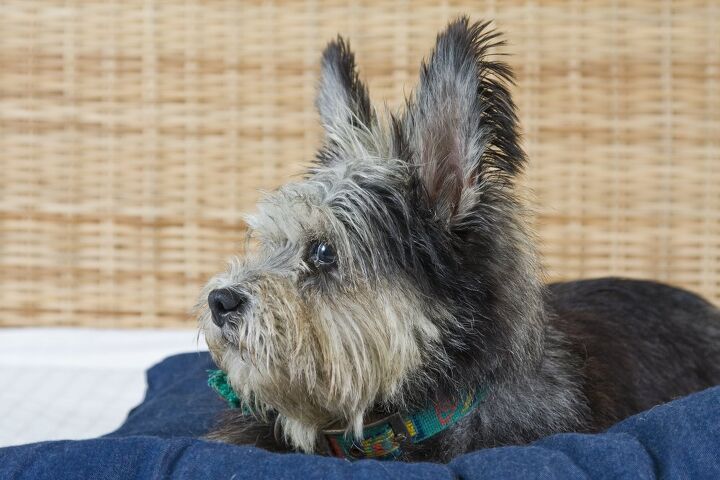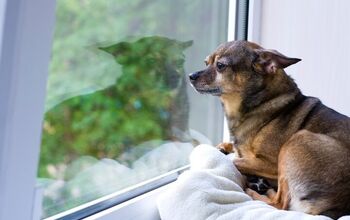Yorwich


About Yorwich
You’d be hard pressed to find a cuter, feistier, more charming designer dog than the Yorwich. These adorable shaggy terrier mixes have compact build and big personalities- a combo proven to win over may a pet owner. Of course, after about five minutes with these little guys, it becomes crystal clear why they are so loved. Their sparky, spunky behavior and the way they strut their cute little butts really doesn’t leave anyone indifferent.
A rare designer dog breed, Yorwich is a mix of two purebred terriers. The breed was developed by breeding Yorkshire Terriers to Norwich Terriers, in hope to produce a new hybrid that would offer the best qualities of both parental breeds. And, boy, were they successful! Owing to his mom and dad, the Yorwich will be a perfect compact companion to those who love active and spirited dogs.
With proper socialization and obedience training, the Yorwich is a playful, energetic, and friendly dog. These hybrids do best in families who are active, outdoorsy, or simply willing to provide a productive outlet for their dog’s boundless energy. A small dog with a personality that’s more suited to a big pooch, the Yorwich has some unique quirks and requirements. Is this designer dog breed the ideal choice for you? Read on to find out!
Owing to his mom and dad, the Yorwich will be a perfect compact companion to those who love active and spirited dogs.
There’s not much we know about the origin of the Yorwich. In fact, you could say that their history is actually a mystery! However, this is not uncommon for designer dog breeds. The majority of hybrids don’t have a well-documented story, with the exception of few of the oldest or most prominent mixes. One of the main reasons for this is that it’s difficult to ascertain when people began intentionally developing a certain mix, rather than it being a product of accidental mating of purebreds. Because, let’s face it: you might not have heard the name Yorwich pop up until a few years back, but it doesn’t mean that Yorkie and Norwich terrier mixes didn’t exist before that.
However, despite the lack of information on the breed, the general history of designer dogs gives us reason to assume that the Yorwich shares his origin story with most other breeds. This would mean that the spunky terrier mix had its start in the United States, sometime in the last 20 years. The breeders behind this hybrid probably wanted to lower the risk of certain breed-specific issues but without losing much of the well-loved characters and appearance of the parental breeds. As the Norwich and Yorkshire Terriers are quite similar in most regards but come from different backgrounds, they managed to achieve their goal.
When you get a Yorwich puppy, they won’t come with their own pedigree papers. Their mom and dad might be purebred- but they’re not, at least not in the eyes of major canine organizations, such as the American Kennel Club. One of the main reasons for this is the lack of uniformity in designer dog breeds, which can only be achieved through generations and generations of selective breeding.
As the mixed breed offspring of a Norwich Terrier and a Yorkie, the Yorwich is a so-called first generation hybrid. This means that his mom and dad are always two purebreds, accounting for the fact that these dogs have 50-50 percent of both parental breeds in their genes. Normally, this would lead to a certain degree of unpredictability, where puppies can look quite different one from another, depending on which parent’s genes are more influential. However, owing to the similarities between the two breeds used to develop Yorwich, the differences within this hybrid breed are not so drastic. However, for the Yorwich to be even considered for the status of a “real” breed, multigenerational crossings are a must.
The Yorwich does best on high-quality dry food for dogs. Kibble- when made from high-grade, natural ingredients- meets the needs of most dogs, but especially those who are smaller in size. Small dog breeds are prone to teeth plaque buildup and early tooth loss, and the dry crunchy kibble promotes good oral health. Combined with good dental hygiene it will dramatically lower the risk of your pet having teeth issues. Of course, not all types of kibble will be a good match for your pet. In fact, there’s a lot of cheap dry food full of fillers that could actually damage your pet’s overall health instead of improving it. Make sure to pick out premium dry food that will suit your Yorwich’s size and activity level, as well as their age group (puppy, adult, or senior). Most high-quality small breed formulas are a good fit.
Additionally, you should pay special attention to portion size. Compact canines such as Yorkie and Norwich mix dog are particularly prone to obesity and diabetes. Do not overfeed or free feed them- usually, a cup of kibble is all they need for the day. Split their daily dose of food into two meals for better digestion.
In addition to basic obedience training, it’s crucial to make sure you socialize your Yorwich on time.
The Yorwich is not a suitable breed for a first-time dog owner. Not unlike most terriers, these mixes are also quite intelligent and stubborn, and they won’t be easy to train unless you had some previous experience. The key with these dogs is to find a method that works and be persistent with it- as well as position yourself as the leader of the pack early on. Naturally, you shouldn’t be harsh or use any aversive techniques, because it will backfire. Your dog will be scared of you and they won’t learn anything from it.
Instead, rely on positive reinforcement training. Using rewards such as treats and praise works wonders with Yorwich, as these willful doggos respond great to this kind of motivation. Just a bit of extra effort and it will pay off! In fact, with some patience and skill, these hybrids could excel at dog sports, such as agility or flyball.
In addition to basic obedience training, it’s crucial to make sure you socialize your Yorwich on time. Socialization plays an important role in the forming of their character. Without it, they could develop small dog syndrome or become aggressive towards other dogs and pets.
The Norwich terrier is slightly larger than the Yorkie, but nothing that would cause major variations in the weight of their mixed breed puppies. Usually, these designer dogs weigh between 6 and 11 pounds.
While the shaggy coat and perky ears might win you over at first glance, it’s the personality of these dogs that really takes the cake. The unique combo of intelligence and alertness with the affection and devotion these dogs have makes them both perfect companions and watchdogs. However, while their qualities are indisputable, not all people will appreciate or match with terriers- Yorwich included. Their tenacity, tendency to bark and energetic nature don’t appeal to everyone. Both of the parental breeds started out as vermin hunters, so you can expect your Yorwich to have a high small prey drive, to boot. Not that they are equipped to hurt anything bigger than a rat, mind you: but it doesn’t mean that they won’t try to chase after the family cat or the stray squirrel in the garden.
However, those who do like all that makes a terrier mix dog will be rewarded with the most loyal, sweet, and entertaining companion. The Yorwich will be a faithful friend, always wanting to be near you but not in a clingy way. They are sweet and loving, and never boring- they will always be in the mood for snuggles or playing.
Yorwich is a mixed breed dog, which means that his proneness to some breed-specific issues is lower than with some purebreds. But, it’s not to say that these designer dogs don’t have any health problems. The health of an individual dog will largely depend on his breeding (healthy parents and responsible breeding practices make for a healthy dog), as well as his lifestyle in general. Lastly, Yorkie and Norwich Terrier mix will still be at risk for some issues that are common for his parents- even if the potential of being affected might be slightly lower.
Some of the problems that your Yorwich might have are epilepsy, hypoglycemia, patellar luxation, collapsing trachea, and eye issues.
Like most small dog breeds, the Yorwich is long-lived and often celebrates his “teen” birthdays. On average, life expectancy for these designer dogs is between 12 and 16 years.
While the Yorwich is an energetic, active pooch, their exercise requirements are still only moderate. In comparison to large athletic dog breeds, these feisty terriers are not all that difficult to tire out! Usually, they do well with a few long walks, a game of fetch in a securely fenced backyard or a visit to the dog park for some quality running around with their furry friends.
Circa 60 minutes of activity will keep your Yorwich happy and out of trouble. And that’s definitely the goal: with those terrier genes and bright minds, these hybrids get bored and frustrated easily. Failing to meet their needs for both physical and mental activity is certain to get you a depressed or destructive pet that will show his displeasure by ruining your valuables. Make sure they get enough outdoors time and offer puzzle toys– these are certain to challenge your smart terrier mix dog.
Circa 60 minutes of activity will keep your Yorwich happy and out of trouble.
Major canine organizations such as the American Kennel Club, UK Kennel Club or Canadian Kennel Club don’t recognize designer dogs. Of course, there are plenty of enthusiasts that have smaller clubs that offer recognition for hybrid dog breeds of all shapes and sizes. Those of them that recognize the Yorwich include the American Canine Hybrid Club, Designer Dogs Kennel Club, Dog Registry of America, and International Designer Canine Registry.
The coat of the Yorwich might be their most varying trait. One of their parents boasts silky, long hair that has to be trimmed and brushed regularly, and the other has a wiry double coat that needs almost no upkeep. The type of hair your little mix will have will largely depend on which parent they favor. If the Yorkie is prevalent, you can expect them to have finer, longer hair that requires brushing a few times a week. In the case the Norwich Terrier genes are more influential, their coat will be more coarse and easier to manage. In either case, these hybrids are not heavy shedders or too high-maintenance when it comes to their grooming requirements.
Coat colors vary, but it’s usually red, wheaten, tan or the combination of black and blue with gold or tan.
Yorwich puppies can be hard to manage: think of them as tiny furballs of pure energy and curiosity. They’ll run around and want to explore everything and everyone and look adorable while at it. However, due to their petite size, these designer puppies are very fragile and can be injured easily. Be careful when handling them and don’t let children play with them without supervision.
At a few weeks of age, your puppy is ready to start learning the basic stuff. Start with obedience training and socialization as early as possible- it might take some effort and patience, but it’s absolutely essential if you want a well-behaved, friendly dog.
Photo credit: Matt Grant/Shutterstock; Annette Shaff/Shutterstock

A proud mama to seven dogs and ten cats, Angela spends her days writing for her fellow pet parents and pampering her furballs, all of whom are rescues. When she's not gushing over her adorable cats or playing with her dogs, she can be found curled up with a good fantasy book.
More by Angela Vuckovic

























